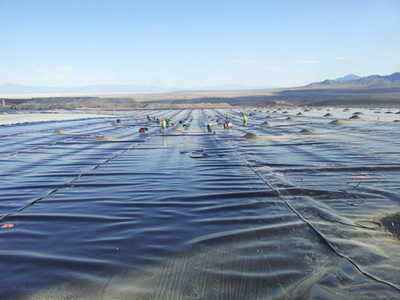 By American Environmental Group – AEG began work on providing geosynthetic installation services for a heap leach pad expansion project for a gold mine in northern Nevada.
By American Environmental Group – AEG began work on providing geosynthetic installation services for a heap leach pad expansion project for a gold mine in northern Nevada.
The mine encompasses a total of approximately 61,389 acres. Operations at the mine involve open pit mining and run-of-mine heap leaching of oxide ore from nearby pits. Phase I of the new leach pad expansion, on which AEG worked, covered an area of approximately 138 acres.
AEG began work in late November 2012 and worked almost until the end of December before weather conditions were no longer favorable for work. After a month of cold, snowy conditions, AEG re-mobilized in February 2013.
Initially, a small crew was mobilized to the site to receive geosynthetic material deliveries and to install the materials located in pond applications. When the quantity of approved subgrade increased, AEG allocated more resources to the site to maximize productivity and safely cover approved subgrade as soon as possible.
In the project, AEG installed and seamed a total of approximately 6,318,058 SF of 80-mil single-sided textured geomembrane. AEG also installed approximately 199,483 SF of 80-mil HDPE drain liner geomembrane, and 28,089 SF of 12-oz nonwoven geotextile.
Two IAGI-certified welding technicians were utilized for the geomembrane seaming.
Approved field seaming processes were dual track double fusion welding for production seams and extrusion welding for repairs. Double fusion welding was used as the primary method of seaming adjacent field panels.
There was an average 140,000 SF of approved subgrade available every day.
Anchor trenches were excavated for the project. The geomembrane was extended into the anchor trench and was seamed along the entire trench distance.
One destructive test sample was taken per 500 feet of seam length from a location specified by the engineer. The pass rate was greater than 98%.
Given the amount of resources devoted to this project, AEG supplied a full-time safety representative to oversee AEG activities. Top-notch safety standards ensured an impressive zero accidents for the entire length of the project.












